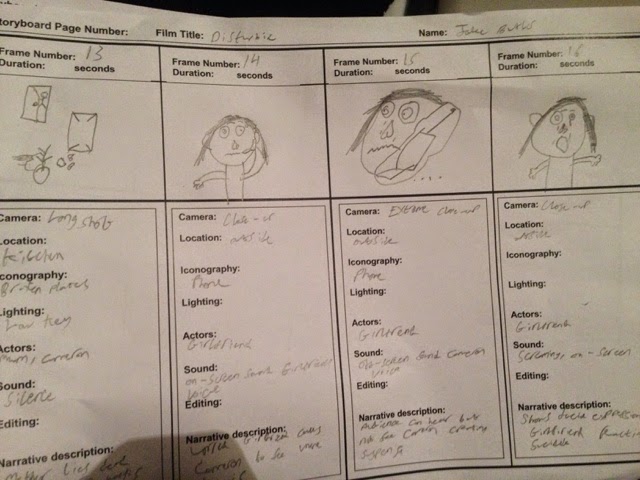Storyboard
The purpose of a storyboard is to help better plan a scene and to also plan each part of the scene and what happens inside of it. It paints a picture for the scenery in a shot and also the overall imagery. It also allows you to plan the sounds, editing and camera angles of what you plan to film and also the order you plan to film it in.
In our groups, we created individual storyboards to share ideas with eachother about our opening sequence and also show each other what we think the scene should plan out like. It also allows us to compare our ideas and what we think is best for the group as a whole for our production, which is why we are creating a group storyboard afterwards.
My individual post will help will help when we are group planning as it will allow us to compare ideas and use the best possible ideas for our group, which means I could possibly have a better idea than the other two people in my group. I have included the general outline of the plot in my storyboard, but also included the sound and editing featured in each shot and also the narrative of what's happening in the scene, which is vital to planning as our group need to understand what is going on. For example, I included low key lighting in some shots, such as the suicide scene at the beginning to create an enigma and also suspense as the audience are awaiting to see what will happen to the character and fear for him, which is how I made this conventional to a thriller and also set the tone for the audience. I expect the audience to be drawn in to my sequence, as suspense is created by slow timing and also various points of silence throughout some shots, such as the dinner scene to create tension and an eery atmosphere for the audience, making them feel uneasy and on edge and also low key lighting dimming in the mood and the overall plot of the sequence, creating suspense and tension throughout.
I have taken inspirations for my sequence from the Alfred Hitchcock classic, Psycho, which is set in low key lighting but also creates suspense for the audience very well for the audience such as the shower scene, which I incorporate into my beginning shots. In conclusion, I believe my storyboard is well laid out and clearly shows what's needed in each scene such as editing, sound and costumes. From my storyboard, I hope my group incorporate my ideas about sound in the first few shots and also the camera angles during the dinner scene as I believe it is best for the scene and creates suspense and tension for the audience well. Doing this individually and sharing back to our group allows us to compare ideas and also decide what frames and overall storyboard slots are best for the group and our final storyboard.





You have provided a sound analysis of your storyboard, explaining what your sequence will consist of and giving examples of micro-elements used at different stages.
ReplyDeleteYou need to:
1) Provide a PEER analysis of the micro-elements listed from your storyboard, explaining what they create and WHY, how a relationship can be built and WHY they are conventional of the genre.
2) Give three different examples of elements used within your storyboard
3) Double check spelling